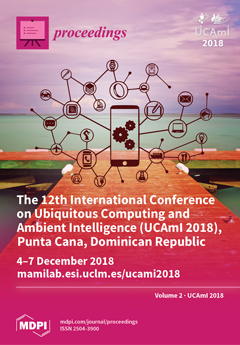Open AccessProceeding Paper
H2Al—The Human Health and Activity Laboratory
by
Kåre Synnes, Margareta Lilja, Anneli Nyman, Macarena Espinilla, Ian Cleland, Andres Gabriel Sanchez Comas, Zhoe Comas-Gonzalez, Josef Hallberg, Niklas Karvonen, Wagner Ourique de Morais, Federico Cruciani and Chris Nugent
Cited by 2 | Viewed by 2160
Abstract
The Human Health and Activity Laboratory (H
2Al) is a new research facility at Luleå University of Technology implemented during 2018 as a smart home environment in an educational training apartment for nurses and therapists at the Luleå campus. This paper presents
[...] Read more.
The Human Health and Activity Laboratory (H
2Al) is a new research facility at Luleå University of Technology implemented during 2018 as a smart home environment in an educational training apartment for nurses and therapists at the Luleå campus. This paper presents the design and implementation of the lab together with a discussion on potential impact. The aim is to identify and overcome economical, technical and social barriers to achieve an envisioned good and equal health and welfare within and from home environments. The lab is equipped with multiple sensor and actuator systems in the environment, worn by persons and based on digital information. The systems will allow for advanced capture, filtering, analysis and visualization of research data such as A/V, EEG, ECG, EMG, GSR, respiration and location while being able to detect falls, sleep apnea and other critical health and wellbeing issues. The resulting studies will be aimed towards supporting and equipping future home environments and care facilities, spanning from temporary care to primary care at hospitals, with technologies for activity and critical health and wellness issue detection. The work will be conducted at an International level and within a European context, based on a collaboration with other smart labs, such that experiments can be replicated at multiple sites. This paper presents some initial lessons learnt including design, setup and configuration for comparison of sensor placements and configurations as well as analytical methods.
Full article
(This article belongs to the Proceedings of
UCAmI 2018)



